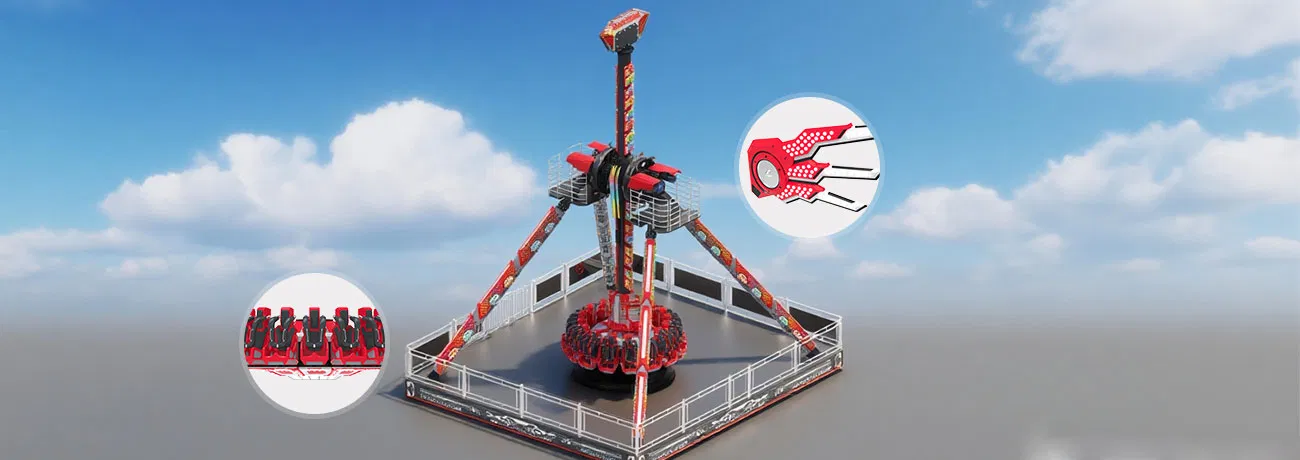The amusement industry thrives on sensory immersion. Beyond the mechanical design and sheer scale of structures, the true hallmark of an unforgettable ride lies in how sound and light orchestrate the experience. These elements are not decorative afterthoughts; they are deliberate tools that heighten perception, amplify emotion, and extend engagement long after the ride concludes. By merging technical precision with creative design, operators and manufacturers elevate simple motion into a dramatic narrative.
The Role of Sound in Ride Dynamics
Sound is one of the most immediate pathways to emotional response. A carefully engineered audio environment can dictate anticipation, tension, and exhilaration. For instance, the creaking buildup before a sudden drop on a roller coaster sets the stage for a visceral release of adrenaline. Low-frequency vibrations simulate physical impact, while high-pitched cues generate urgency.
The pendulum swing amusement ride exemplifies this application. When accompanied by escalating beats synchronized with each swing, the arc feels more intense. The auditory rhythm parallels the rider’s heart rate, creating a feedback loop of excitement. Surround sound systems embedded within ride platforms also ensure uniform delivery, preventing uneven experiences across seating positions.
Light as a Catalyst for Immersion
Light exerts equal influence by manipulating visual attention. Dynamic lighting patterns can exaggerate speed, distort perception, and evoke theatrical suspense. Color psychology plays a pivotal role: warm hues generate energy, while cooler tones can introduce calmness or eerie undertones.
The ferris wheel demonstrates this duality. Traditionally a contemplative attraction, it transforms under LED arrays and programmable sequences into a beacon visible across entire funfair grounds. Light choreography not only attracts visitors but also turns the structure into a landmark spectacle that extends its commercial value beyond riders.
Synergy Between Sound and Light
The convergence of sound and light magnifies their individual effects. When perfectly synchronized, they create a multisensory illusion that extends beyond the physical limitations of machinery. A roller coaster supplier may provide the same steel track to multiple venues, yet those who invest in integrated sensory systems deliver far more compelling outcomes.

Consider the moment a coaster climbs its first hill. As tension builds, minimal lighting and subdued tones intensify focus. When the descent begins, explosive strobe effects paired with synchronized audio blasts amplify the sensation of freefall. This coordination reshapes perception, turning mechanical descent into a cinematic event.
Technological Advancements
Modern systems leverage programmable LED fixtures, advanced audio processors, and motion-triggered sensors. These tools enable rides to respond dynamically to motion rather than relying on static sequences. A pendulum swing amusement ride can now feature lighting arcs that mirror the trajectory in real time, while sub-bass speakers simulate the rush of wind or mechanical groaning.

Furthermore, wireless control platforms grant operators precise oversight, allowing adjustments to volume, brightness, and timing with minimal latency. This adaptability means attractions can modify experiences based on time of day, audience demographic, or thematic event without structural alteration.
Commercial Implications
Enhancing rides with sound and light yields measurable economic benefits. At a funfair ride for sale exhibition, prospective buyers increasingly prioritize attractions with integrated sensory packages. These augmentations justify higher pricing and improve return on investment by attracting larger crowds.

Operators also leverage these features for marketing. Photographs and videos of glowing rides accompanied by pulsating soundscapes spread readily across social platforms, serving as organic promotion. The spectacle itself becomes content, reducing reliance on traditional advertising.
Case Studies Across Ride Types
Roller Coaster
A leading roller coaster supplier integrated fiber optic lighting along track edges, creating a trail of illumination that followed cars at night. When paired with synchronized onboard speakers, riders perceived speed as nearly doubled, despite identical mechanical parameters.
Ferris Wheel
An urban ferris wheel installation employed 60,000 LED nodes capable of forming intricate light shows. Paired with ambient music broadcast across the plaza, the ride drew non-riders who engaged with surrounding concessions, significantly increasing site revenue.

Pendulum Swing
One pendulum swing amusement ride incorporated directional sound beams aimed at queues. Waiting riders heard deep mechanical roars synchronized with visible lighting tests. This priming effect heightened anticipation before boarding, prolonging the emotional arc of the experience.
Psychological Dimensions
Human cognition processes sound and light faster than physical motion. By stimulating these senses in advance of actual forces, designers manipulate expectations. Anticipatory cues build suspense, while delayed cues exaggerate aftermath. This temporal misalignment heightens intensity without additional mechanical strain.
Moreover, synchronization of sensory effects fosters collective participation. Riders scream in unison when stimuli align, creating communal memory. Such shared reactions become stories retold long after departure, expanding the reach of the attraction.
Future Directions
Emerging technologies will further refine the interplay of sensory design. Augmented reality projections may overlay digital imagery onto physical rides, while spatial audio can simulate moving sources independent of ride trajectory. Sustainability will also influence development, with energy-efficient LEDs and smart power management ensuring reduced operational costs.
Manufacturers who anticipate these trends will maintain competitive advantage, especially as demand grows for modular systems that can be retrofitted onto existing structures. Whether it is a ferris wheel glowing across a city skyline or a roller coaster thundering with choreographed sound, the future of amusement rides lies in multisensory orchestration.
Conclusion
The enhancement of amusement rides through sound and light is not superficial embellishment but a deliberate elevation of experience. From pendulum swing amusement ride designs to grand ferris wheel installations, these sensory augmentations define the atmosphere, memory, and commercial success of attractions. When combined with robust engineering and imaginative artistry, sound and light transform machinery into storytelling devices—ensuring every ride transcends mechanics to become a moment of wonder.